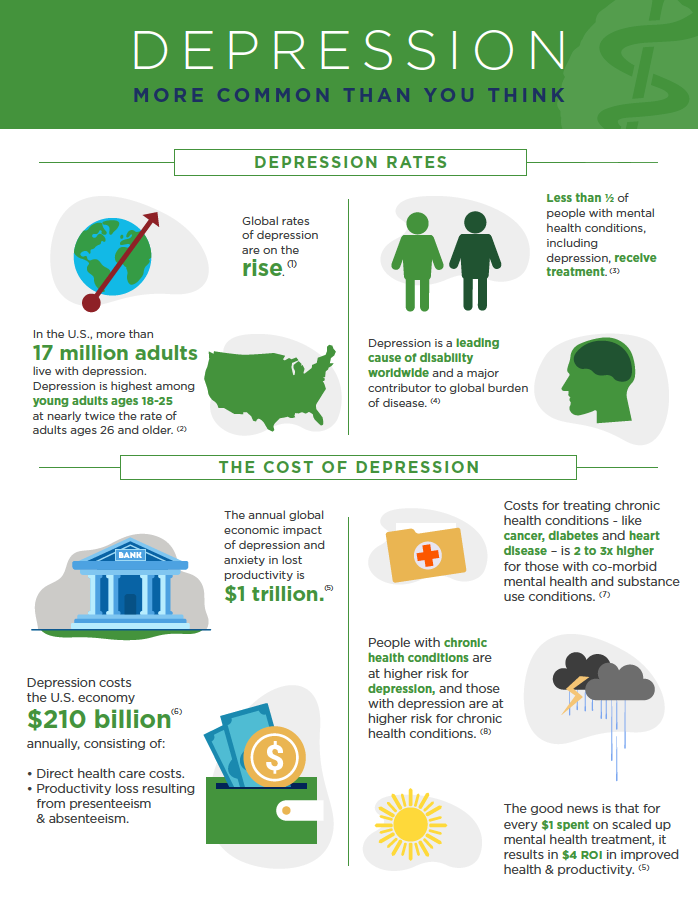
Depression: A Costly Condition for Businesses
Why are more employers focusing on workplace mental health? Because they recognize it is costly to ignore. Depression costs employers an estimated $44 billion each year in lost productivity. About half of employees with depression are untreated. Yet with proper treatment, people with depression can get better. The key is to help employees access effective care.
What Is Depression?
Depression is not just about having a bad day. It can be more serious and negatively affect how a person feels, thinks and acts, decreasing their ability to function well at home and at work.
According to American Psychiatric Association’s Depression page, depression is diagnosed if a person experiences these symptoms for more than two weeks:
- Feeling sad
- Loss of interest in pleasure in activities previously enjoyed
- Difficulty concentrating and making decisions
- Changes in appetite, overeating or not eating enough
- Trouble sleeping, or sleeping too much
- Fatigue
- Restless activity (e.g., hand-wringing or pacing) or slowed movements and speech
- Feelings of worthlessness or guilt
- Thoughts of suicide or self-harm
Depression affects an estimated 16 million Americans or almost 7% of the population . It can strike at any time but often first appears during the late teens to mid-20s. Women are more likely than men to experience depression.
Depression can affect anyone—even a person who appears to live in relatively ideal circumstances.

How Does Depression Impact the Workplace?
Depression, left untreated, may have a significant impact on work performance . It contributes to presenteeism, or employees at work but not engaged, and absenteeism, or employees missing days of work. It may also adversely impact multiple areas of employee performance, including focus and decision making, time management, completing physical tasks, social interactions, and communication . Like most other health conditions, early detection and effective treatment lessen the severity and impact of the condition.
Employers can play a key role in supporting the early identification of depression and other mental health conditions and improving access to care. It’s an investment well worth making.
Tips for Employers
Awareness
Educate employees and managers about mental health conditions, including depression, and encourage employees to seek help when needed. Mental health remains a taboo topic so train supervisors and employees on how to start a conversation if they are concerned about an employee. Integrate mental health information into all health communication strategies. Include content about depression in company newsletters, on the intranet and in other regular employee communication platforms.
Consider an initiative that brings a discussion about depression out in the open and encourages employees to seek help when needed. The Center for Workplace Mental Health and a national employer coalition, Employers Health, created Right Direction, for just this purpose. This turn-key initiative provides employers with tools to:
- Raise awareness about depression in the workplace and its effect on productivity;
- Promote early recognition of symptoms; and
- Reduce the stigma surrounding mental health conditions.
Through Right Direction, employers have access to a library of customizable high impact tools and resources. The materials are accessed by thousands of employers addressing workplace mental health.
The more employers raise the visibility of mental health, the more it will be normalized, increasing the likelihood that employees will seek care when needed.
Here is helpful information to share with employees and managers to raise awareness about depression in the workplace:
What Depression Feels Like
- Deep feelings of sadness
- Loss of Interest in work or social activities
- Difficulty concentrating, slowed thoughts
- Forgetfulness and trouble remembering
- Trouble making decisions
- Trouble sleeping, or sleeping too much
- Feelings of worthlessness or inappropriate guilt
- Energy loss or increased fatigue
- Irritability, anger or tearfulness
- Weight or appetite changes
How Depression Looks to Co-Workers
- Withdrawal from team, isolates oneself
- Indifference
- Putting things off, missed deadlines, accidents
- Seems “scattered” or absentminded
- Procrastination, indecisiveness, slowed productivity
- Late to work, afternoon fatigue, accidents
- Unsure of abilities, lack of confidence
- Low motivation, detached
- Inappropriate reactions, strained relationships
- Change in appearance

Accessibility
Employers are uniquely positioned to encourage employees to get help if they are experiencing depression. One important step is to include depression screening in health risk appraisals (HRAs) and EAP programs. Employers should also confirm that their health plans are using a validated screening tool, like the nine-item Patient Health Questionnaire (PHQ-9).
Employers should also inform their health plans that they want primary care clinicians to conduct routine depression screenings and to offer collaborative care. This research-based model of care has more than 80 studies showing its effectiveness in improving treatment outcomes. Collaborative care is provided in the primary care setting with a care manager, a primary care provider and a specialty mental health provider. It is essential that employers require their health plans to turn on the CPT billing codes for collaborative care, that became available in 2017 and allow providers to bill for the care.
Assistance
Promote the use of employee assistance and health programs. Early intervention is key. Remind employees of the availability of resources for staying mentally and physically healthy and productive. Inform employees often on how to access mental health information and care confidentially and quickly. Push these messages out during times of high stress, during the holiday season and especially when there is activity that employees may view as disruptive in the workplace and broader community.
The Bottom Line
When depression is effectively addressed in the workplace, it promises to lower total medical costs, increase productivity, lower absenteeism and decrease disability costs. The bottom line: investing in a mentally healthy workforce is good for business.
Depression by the Numbers
- 16 million Americans affected by depression every year.
- 50% Of people with depression are untreated.
- $44 billion The cost to employers of workplace depression.
- 40-60% Reduction in absenteeism and presenteeism with treatment.
- $1 Of investment in treatment for depression and anxiety leads to a return of $4 in better health and work performance.
You must be logged in to post a comment.